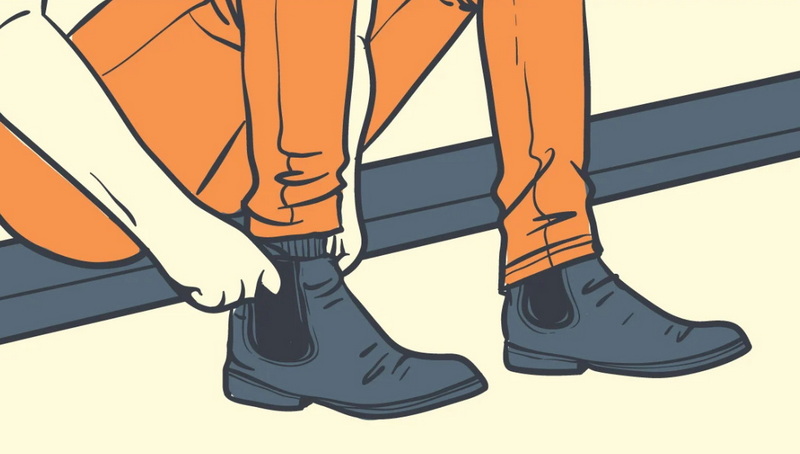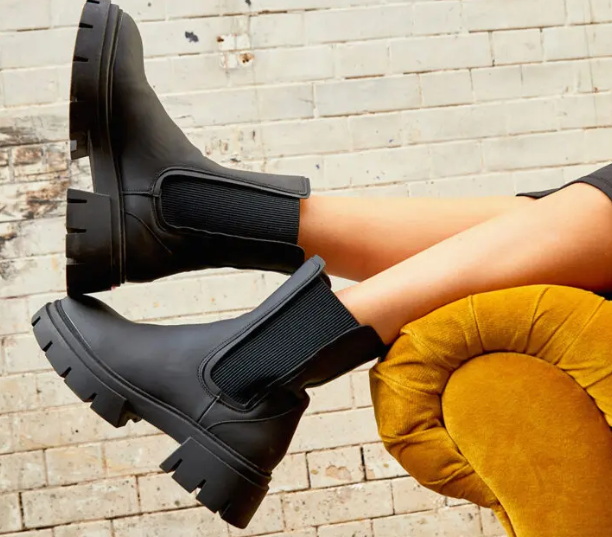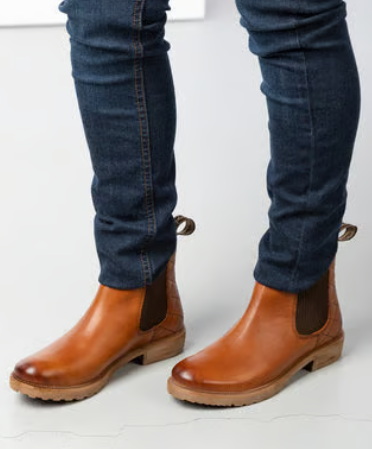Content Menu
● The Importance of Fit in Chelsea Boots
● Key Elements of a Perfect Fit
>> Snug Heel Fit
>> Comfortable Toe Box
>> Elastic Side Panels
>> Ankle Fit
● How to Check for Fit
● Tips for Choosing the Right Size
● Common Issues with Fit
● Taking Care of Your Chelsea Boots to Maintain Fit
● Advanced Tips for the Perfect Chelsea Boot Fit
● The Long-Term Benefits of a Well-Fitted Boot
● Conclusion
● FAQ
>> 1. What should I do if my Chelsea boots are too tight?
>> 2. How much space should be in the toe box?
>> 3. Is it normal for heels to slip slightly in Chelsea boots?
>> 4. Should I buy Chelsea boots in my regular shoe size?
>> 5. How do I break in new Chelsea boots?
Chelsea boots are a timeless footwear choice that combines style and functionality. Their sleek design and versatile nature make them a staple in many wardrobes. However, finding the perfect fit is crucial to ensure comfort and maintain the boot's elegant appearance. This article will guide you through the essential aspects of fitting Chelsea boots, how to check for the right size, and tips for ensuring a snug fit. We will also include visual aids and a comprehensive guide, followed by a conclusion summarizing key points, and a FAQ section addressing common questions related to Chelsea boot fitting.

The Importance of Fit in Chelsea Boots
A well-fitted Chelsea boot not only enhances your style but also provides comfort throughout the day. Poorly fitted boots can lead to blisters, discomfort, and an unflattering appearance. Wearing boots that are too tight can restrict blood flow, leading to foot pain and potential long-term issues like bunions or hammertoes. Conversely, boots that are too loose can cause instability, increasing the risk of trips and falls. Understanding how Chelsea boots should fit is essential for both new buyers and seasoned wearers. It's not just about aesthetics; it's about foot health and overall well-being.
Key Elements of a Perfect Fit
Snug Heel Fit
The heel of your Chelsea boots should fit snugly without slipping out when you walk. A loose heel can cause instability and discomfort, while a tight heel can lead to pinching and blisters. The fit around the heel is particularly important because it anchors your foot within the boot. When trying on Chelsea boots, pay close attention to how your heel feels as you walk. It should feel secure, not like it's constantly trying to escape the confines of the boot.
Comfortable Toe Box
Your toes should have enough room to wiggle without feeling cramped. Ideally, there should be about a thumb's width of space between your longest toe and the front of the boot. This allows for natural foot movement and prevents pressure points from forming. A cramped toe box can lead to issues like ingrown toenails and nerve compression. When trying on Chelsea boots, wiggle your toes to ensure they have sufficient space. If you feel any pressure or restriction, the boots are likely too small.
Elastic Side Panels
The elastic side panels are a distinctive feature of Chelsea boots. They should allow for easy entry while providing a snug fit around the ankle. The elasticity of these panels is crucial for accommodating different ankle sizes and ensuring a comfortable fit. Over time, the elastic may stretch slightly, but it should maintain enough tension to keep the boots securely in place. Check that the elastic is not overly stretched or saggy, as this can indicate poor quality or excessive wear.
Ankle Fit
Chelsea boots should fit closely around the ankle without any gaps. Gaps can detract from their streamlined look and may lead to slippage. The ankle fit is essential for achieving the sleek silhouette that Chelsea boots are known for. The boot should gently hug your ankle without feeling constrictive. This ensures a secure and comfortable fit, preventing the boot from looking awkward or feeling unstable.
How to Check for Fit
To ensure that your Chelsea boots fit perfectly, consider these steps:
1. Wear the Right Socks: Choose socks that you would typically wear with your boots. The thickness of your socks can significantly impact the fit. Thinner socks are ideal for warmer weather, while thicker socks can provide additional cushioning and warmth during colder months. When trying on Chelsea boots, it's best to wear socks that closely resemble what you would typically wear with them. This will give you a more accurate sense of how the boots will fit in everyday situations.
2. Walk Around: Take several steps in the boots to assess comfort and stability. Pay attention to any pinching or slippage. Walking around in the boots allows you to evaluate how they feel in motion. Are there any areas that rub uncomfortably against your skin? Does your heel feel secure, or does it slip out with each step? Pay attention to how the boots flex as you walk. They should bend naturally with your foot without feeling stiff or restrictive.
3. Check Toe and Heel Space: Ensure there is adequate space in the toe box and that your heel fits snugly without excessive movement. Use your fingers to feel around the toe box to assess the amount of space available. You should be able to press down on the toe of the boot without feeling your toes pressed against the front. Similarly, check that your heel feels secure and doesn't lift excessively as you walk.
4. Try Them Later in the Day: Feet tend to swell throughout the day, so trying on boots in the afternoon or evening can help you find a more accurate fit. Your feet naturally expand as you go about your daily activities. Trying on boots later in the day accounts for this swelling, ensuring that you choose a size that will remain comfortable even after hours of wear. If you try on boots in the morning, they may feel comfortable initially but become too tight as your feet swell later in the day.

Tips for Choosing the Right Size
- Measure Your Feet: Use a ruler or measuring tape to measure your foot length and width accurately. This will help you select the correct size based on sizing charts provided by brands. Place your foot on a piece of paper and trace around it. Then, measure the length from the heel to the longest toe and the width at the widest point. Compare these measurements to the sizing charts provided by the brand you are considering. Keep in mind that sizing can vary between brands, so it's always a good idea to consult the specific chart for the manufacturer.
- Consider Width: Chelsea boots are generally narrower than other types of boots. Ensure that they are snug but not too tight around the sides. The width of your foot is an important consideration when choosing Chelsea boots. If you have wide feet, look for brands that offer wider width options. A boot that is too narrow can cause discomfort and even lead to foot problems over time. Check online reviews to see if other customers with similar foot widths have found the boots to be a good fit.
- Account for Stretching: Leather and elastic materials may stretch over time, so starting with a snug fit is essential. Leather is a natural material that tends to mold to the shape of your foot over time. The elastic side panels may also stretch slightly with wear. Therefore, it's best to choose a size that feels snug initially, as it will likely loosen up slightly as you break in the boots. Avoid choosing a size that feels too loose, as it will only become more so over time.
Common Issues with Fit
- Heel Slippage: A small amount of movement is normal; however, if your heel slips excessively, consider trying a smaller size. Heel slippage can be a common issue with Chelsea boots, especially if the fit is not quite right. Try tightening the boots by wearing thicker socks or adding heel grips to the inside of the boot. If the slippage persists, it may be necessary to try a smaller size or a different brand with a more accommodating heel cup.
- Pinching at the Toes: If you experience pinching or discomfort at the toes, it may indicate that the boot is too small or narrow. Toe pinching can be extremely uncomfortable and can lead to blisters and other foot problems. If you experience pinching at the toes, try loosening the laces (if applicable) or wearing thinner socks. If the pinching persists, it's essential to choose a larger size or a wider width.
- Gaps Around Ankle: If there are noticeable gaps around your ankles when wearing the boots, they may be too large. Gaps around the ankle can make the boots look awkward and can also lead to slippage. Try wearing thicker socks or adding an insole to fill up some of the space. If the gaps are still noticeable, it's best to choose a smaller size or a different style with a more fitted ankle.
Taking Care of Your Chelsea Boots to Maintain Fit
- Regular Cleaning: Clean your Chelsea boots regularly to prevent dirt and grime from damaging the leather or elastic. Use a soft cloth and a mild leather cleaner to remove any buildup.
- Conditioning: Condition the leather periodically to keep it supple and prevent it from drying out and cracking. Apply a leather conditioner according to the manufacturer's instructions.
- Proper Storage: Store your Chelsea boots in a cool, dry place away from direct sunlight. Use shoe trees to help maintain their shape and prevent them from creasing.
Advanced Tips for the Perfect Chelsea Boot Fit
1. Consider the Brand: Different brands have different lasts (the foot-shaped form around which the shoe is constructed), which can significantly affect the fit. Research brands known for fitting your foot type.
2. Pay Attention to the Arch Support: While Chelsea boots are not known for their arch support, you can add aftermarket insoles for better comfort, especially if you have high or low arches.
3. Try on Multiple Pairs: Even within the same size, there can be slight variations. Trying on multiple pairs can help you find the most comfortable fit.
4. Consult a Professional: If you are unsure about your size or have specific foot issues, consider consulting a professional shoe fitter for personalized advice.
5. Check the Sole: The type of sole can affect the overall comfort and stability of the boot. Leather soles are classic but can be slippery, while rubber soles provide better traction.
The Long-Term Benefits of a Well-Fitted Boot
Investing time and effort into finding the right fit for your Chelsea boots pays off in the long run. Comfortable, well-fitted boots not only prevent foot problems but also enhance your overall posture and reduce strain on your joints. You'll find yourself reaching for your Chelsea boots more often, knowing that you can rely on them for both style and comfort.
Conclusion
Finding the right fit for Chelsea boots is crucial for both comfort and style. Pay attention to key areas such as heel fit, toe box space, elastic side panels, and ankle snugness. By following these guidelines, you can ensure that your Chelsea boots not only look great but also feel comfortable throughout your day. Remember to consider factors like sock thickness, foot swelling, and brand variations when selecting your size. With a little patience and attention to detail, you can find the perfect pair of Chelsea boots that will provide years of stylish comfort.

FAQ
1. What should I do if my Chelsea boots are too tight?
If your Chelsea boots feel too tight, consider trying them on with thinner socks or using a shoe stretcher to gently expand them. You can also try wearing them around the house for short periods to help them break in gradually. If the boots are made of leather, applying a leather stretching spray can also help to soften the material.
2. How much space should be in the toe box?
There should be approximately a thumb's width of space between your longest toe and the front of the boot for optimal comfort. This allows your toes to move freely and prevents pressure points from forming. When trying on boots, wiggle your toes to ensure they have sufficient space.
3. Is it normal for heels to slip slightly in Chelsea boots?
Yes, a small amount of heel slippage is normal; however, if it's excessive, you may need to try a smaller size. You can also try adding heel grips to the inside of the boot to provide more friction and prevent slippage. If the heel slippage is significant, it can lead to blisters and discomfort.
4. Should I buy Chelsea boots in my regular shoe size?
Generally, yes; however, if you are between sizes or have wider feet, consider sizing up for comfort. It's always a good idea to try on boots in person or order multiple sizes online and return the ones that don't fit. Keep in mind that sizing can vary between brands, so it's essential to consult the specific sizing chart for the manufacturer.
5. How do I break in new Chelsea boots?
Wear them around your home with thick socks for short periods until they soften up; this will help them mold to your feet without causing discomfort. You can also use a leather conditioner to soften the leather and make it more pliable. Applying a leather stretching spray can also help to speed up the break-in process.

















